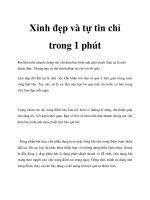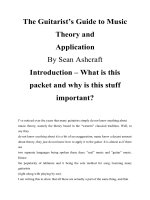Music Theory FundamentalsSection 1.5 ppt
Bạn đang xem bản rút gọn của tài liệu. Xem và tải ngay bản đầy đủ của tài liệu tại đây (174.9 KB, 2 trang )
LearnMusicTheory.net High-Yield Music Theory, Vol. 1: Music Theory Fundamentals
16
Section 1.5
T I M E S I G N A T U R E S I N S I M P L E M E T E R
A beat is a repeating musical pulse. Listeners sense the beat when they tap
their feet or clap their hands in time with the music. Musicians group beats
into units called measures or bars. Every measure ends with a barline. A
special final barline indicates the end of the movement or piece.
A time signature (or meter signature) indicates how many beats there are
in one measure and what rhythmic value gets one beat (this value is called
the beat unit). For time signatures in simple meter, the top number is the
number of beats in each measure, and the bottom number is the beat unit.
Time signatures are not fractions, so there is no line between the numbers.
Meters (that is, time signatures) with two beats per measure are duple,
those with three beats are triple, and those with four beats are quadruple.
Each beat in simple meter divides into two equal beat divisions, or four
equal beat subdivisions. Below, one quarter note beat equals two eighth
notes or four sixteenth notes; see 1.4 Rhythmic Values.
&
measure or bar measure or bar
barline
measure or bar
final barline
œ
œ
œ
œ
œ œ ˙
œ œ ˙
4
4
&
1
4
4
2
= 4 beats in each measure
= q gets one beat
3 4 1 2 3 4 1 2 3 4
œ
œ
œ
œ
œ œ ˙
œ œ ˙
2
4
3
4
4
4
&
1
Duple meter:
= 2 beats
= q gets beat
2
4
2
&
1
Triple meter:
3
4
= 3 beats
= q gets beat
2 3
&
1
Quadruple meter:
4
4
= 4 beats
= q gets beat
2 3 4
œ œ œ œ œ œ œ œ œ
2
4
2
4
2
4
&
1
Beat units:
2
_
_
_
&
1
Beat divisions:
2
_
_
_
&
1
Beat subdivisions:
2
œ œ œ œ œ œ œ œ œ œ œ œ œ œ
Beat
Measure
Bar, Barline
Final barline
Time signature
Beat unit, Simple
time signature
Duple, Triple,
Quadruple
Beat division and
subdivision
Chapter 1: Music Notation
17
The bottom number in a simple time signature indicates the beat unit: two
means half note, four means quarter, eight means eighth, and so on. The
first time signature below is also called cut time or alla breve. The second
time signature is common in Baroque music; sometimes the eighth notes
are written with flags instead of beamed together. The last time signature is
sometimes called common time.
An anacrusis (or pickup measure) is a partial measure that begins some
pieces. An anacrusis is often one beat long, but not always. If there is an
anacrusis, the final measure will be shortened so that the anacrusis and the
final, shortened measure together equal the length of one regular measure.
The downbeat is the first beat of each measure. The downbeat is
fundamental and stable (a strong beat) because it initiates each new group
of beats. The last beat of each measure is unstable (a weak beat) because it
pulls forward to the following measure. The last beat of a measure often
seems to have more energy than the downbeat, because it propels the
rhythm forward to the more stable, stronger downbeat.
The following stress patterns for beats are common:
1. Duple meters: Meters with two beats follow a STRONG-weak stress
pattern for the two beats.
2. Triple meters: Meters with three beats follow a STRONG-weak-weak
stress pattern for the three beats.
3. Quadruple meters: Meters with four beats follow a STRONGEST-
weak-STRONG-weak pattern for the four beats.
2
2
3
8
4
4
&
1
2
2
is sometimes written
2
2
= 2 beats
= h gets beat
2
C
&
1
3
8
= 3 beats
= e gets beat
2 3
&
1
4
4
is sometimes written
4
4
= 4 beats
= q gets beat
2 3 4
c
˙ ˙ œ œ œ œ œ œ œ
4
4
&
1
anacrusis
(pickup)
1 2 3 4 1 2 3 4
shortened final bar
(because of the anacrusis)
1 2 3
œ
œ
œ
œ
œ
œ
œ
œ
œ
œ
œ
œ
Other beat units
Cut time
Alla breve
Common time
Anacrusis
Pickup measure
Downbeat
Strong beat
Weak beat
Stress patterns









